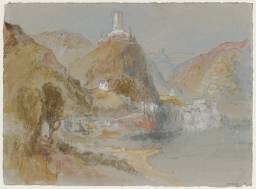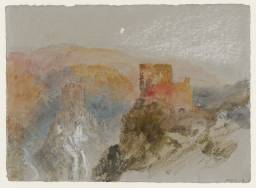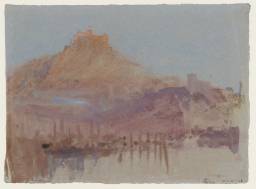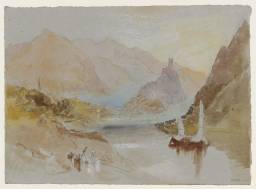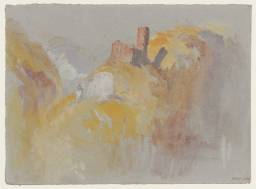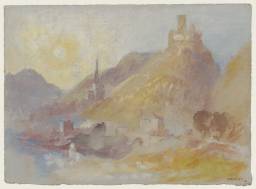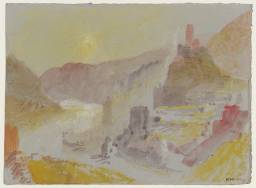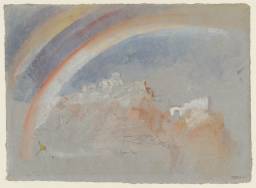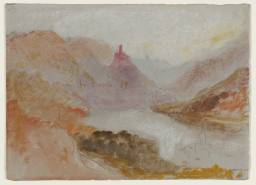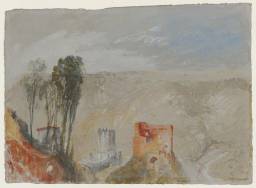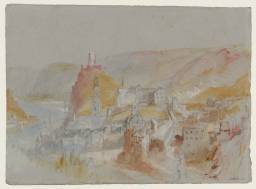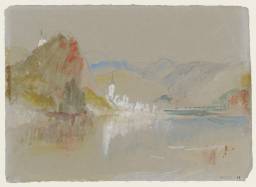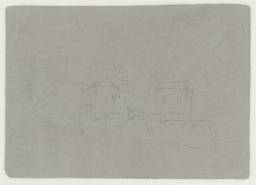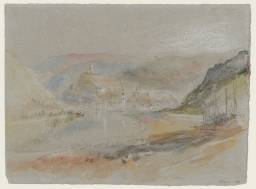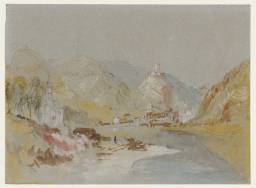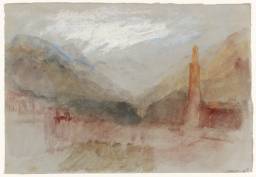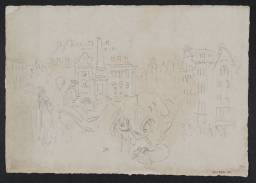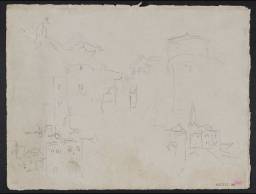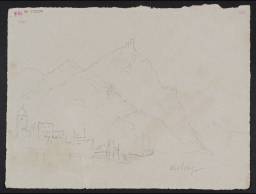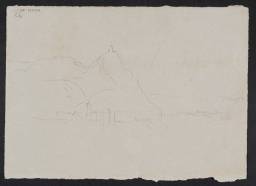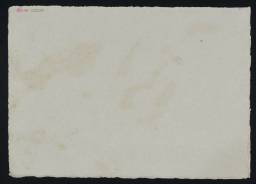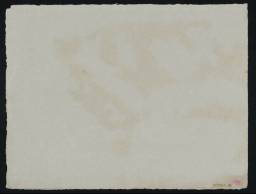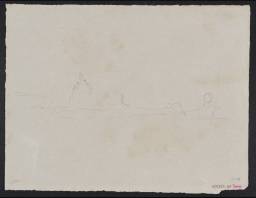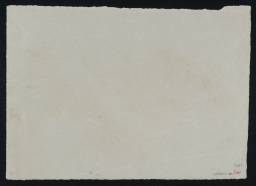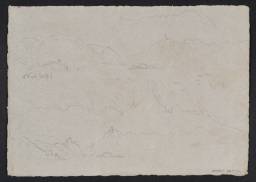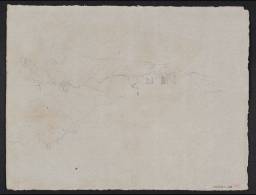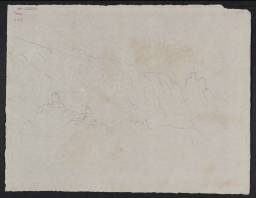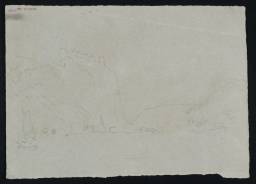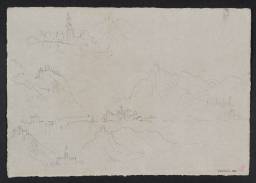D28949–D28950, D28955, D28957, D28963, D28966–D28967, D28974, D28979, D28987–D28988, D28992, D28998–D29000, D29020, D32189, D33899–D33914, D36079, D36085, D36152, D36154–D36156, D36168, D36173, D40177, D40178, D40188, D40319, D41474, D41476, D41477
Turner Bequest CCXCII 2, 3, 3v, 8, 10, 16, 19, 20, 27, 27v, 32, 40, 41, 45, 45v, 50, 50v, 51, 69, CCCXVII 10, CCCXLI 194–209, CCCLXIV 233, 239, 295, 297–299, 310, 315
This section comprises pencil sketches and colour studies of subjects from the three weeks or so of Turner’s outwards route through Germany, Austria and northern Italy towards Venice, which he reached on 20 August 1840, as set out in the Introduction to the tour. Complementing pencil drawings in the Rotterdam the Venice sketchbook (Tate; Turner Bequest CCCXX), they are mostly on sheets of the pale grey English Bally, Ellen and Steart paper he had brought with him, also used subsequently among other sorts and colours in Venice and on his return journey (see the listing in the technical notes to the overall Introduction).
Turner shared the first stages of his journey from London with his cousin and solicitor Henry Harpur and his wife Eleanor, who were with him as far as Bregenz as they entered Austria, likely around 10 August, before the couple went their own way to Rome. Meanwhile, there had been a brief detour up the River Mosel as far the Cochem area, about twenty miles due south-west from the confluence with the Rhine at Coblenz. Except for Burg Eltz and Trutz Eltz, a little away from the river, the artist was familiar with these picturesque castles and riverside towns from his tours of 1824 and as recently as 1839, when he had worked on blue paper; comparable works from those visits are noted in the entries here. The sites are listed as they run upstream from the Rhine:
the Leyen Burg, Gondorf: Tate D40319, D28999 (verso of Turner Bequest CCXCII 2, CCXCII 50v); Alken and Burg Thurandt: D28949 (CCXCII 2); Burg Bischofstein: D28966 (CCXCII 19); Burg Eltz and Trutz Eltz: D28955, D28988 (CCXCII 8, 41); Treis: D28998 (CCXCII 50); Klotten and Burg Coraidelstein: D28967 (CCXCII 20); Cochem: D28950 and D41477, D28963, D28974 and D41474, D28987, D28992 and D41476, D29000, D29020 (CCXCII 3, 3v, 16, 27, 27v, 40, 45, 45v, 51, 69)
In discussing one of the Mosel subjects in this subsection (Tate D28998; Turner Bequest CCXCII 50), Cecilia Powell has noted that it ‘originally formed part of the same sheet as eight others of the same size which bear pencil drawings of the Rhine on both recto and verso. These include views of Bonn, the Godesburg, Rolandseck, the Drachenfels, Hammerstein and Burg Rheineck’.1 This format (about 140 x 190 mm) was used ‘chiefly in the Middle Rhine and Mosel regions’.2 The subjects are identified individually here, and lie along a stretch running upriver roughly twenty-five miles south-eastwards from Bonn towards Andernach:
the marketplace at Bonn: D33899 (CCCXLI 194); other aspects of the city (D33900; CCCXLI 195); the Godesburg (D33905; CCCXLI 200); the Drachenfels and its ruins (D33901–D33902, D33912; CCCXLI 196, 197, 207); Burg Rolandseck (D33908; CCCXLI 203); general views of Burg Rolandseck, Nonnenwerth and the Drachenfels (D33907, D33911; CCCXLI 202, 206); Burg Rheineck (D33909; CCCXLI 204); Burg Hammerstein (D33910, D33913–D33914; CCCXLI 205, 208, 209)
Turner returned this way a few weeks later, using the Würzburg, Rhine and Ostend sketchbook (Tate; Turner Bequest CCCIII).
The next separate studies, this time on different blue paper, were made at Bregenz, although the four now known were dispersed (see the Introduction to the tour); one pencil sketch made there was retained, on the other side of one of the Bolzano sheets listed below. Then, after much mountainous travelling, comes a short sequence of Landeck in Austria and its castle. These are the only works in this grouping on conventional white paper, which is not an immediate match for others used in 1840, albeit they seem to have been drawn on the spot (D36079, D36085, D36168, D36173; Turner Bequest CCCLXIV 233, 239, 310, 315).
Not long afterwards, Turner stayed at Bolzano (Bozen), the capital of Alto Adige province, now in northern Italy but then under Austrian rule. He had paused here on his return from Venice in 1833 to make numerous drawings of the mountains and castles in the area; see the Introduction to that year’s Venice up to Trento sketchbook (Tate; Turner Bequest CCCXII). This time he made two colour studies of the fine prospect of the town and the Dolomites from his hotel window (D32189, D36152; CCCXVII 10, CCCLXIV 295), and others of the castles in the valley of the Torrente Talvera (Talferbach) just outside the city (D36154–D36156; Turner Bequest CCCLXIV 297–299, with their respective versos: D40188, D40177, D40178, the second of which is the Bregenz drawing mentioned above). These were the last subjects on separate sheets before he reached Venice, although he continued to use the Rotterdam to Venice book.
As will be seen from the individual entries, the identifications and dating of these sheets are particularly indebted to Cecilia Powell’s research for her 1995 Tate Gallery exhibition Turner in Germany, when many were exhibited and others noted in the context of the 1840 tour.
How to cite
Matthew Imms, ‘The Route to Venice: The Rivers Mosel and Rhine; Landeck; Bolzano (Bozen) 1840’, subset, September 2018, in David Blayney Brown (ed.), J.M.W. Turner: Sketchbooks, Drawings and Watercolours, Tate Research Publication, December 2019, https://www


